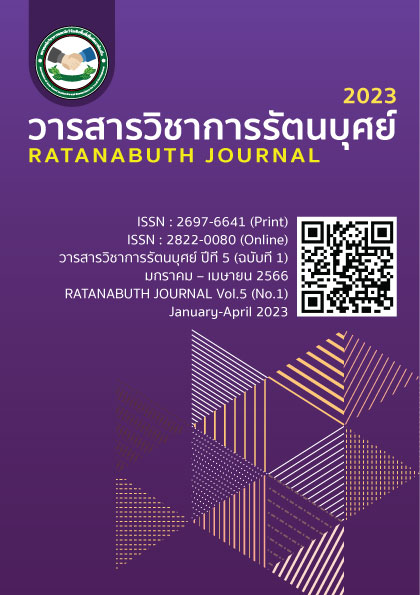ปัจจัยเชิงสาเหตุและผลลัพธ์ของความสมดุลระหว่างชีวิตและการทำงานของพนักงานฝ่ายเทคโนโลยีสารสนเทศเจนเนอเรชั่นวายบริษัทเอกชนเขตกรุงเทพมหานคร The Antecedents and Consequences of Work Life Balance Information Technology Generation Y Employees in Private Companies in Bangkok
Main Article Content
บทคัดย่อ
งานวิจัยนี้มีวัตถุประสงค์เพื่อศึกษาปัจจัยเชิงสาเหตุและผลลัพธ์ของความสมดุลระหว่างชีวิตและการทำงานของพนักงานฝ่ายเทคโนโลยีสารสนเทศเจนเนอเรชั่นวายบริษัทเอกชนเขตกรุงเทพมหานคร การศึกษานี้มีวัตถุประสงค์คือ 1) เพื่อศึกษาระดับความคิดเห็นของระบบการทำงานที่ยืดหยุ่น การรับรู้การสนับสนุนของผู้บังคับบัญชา แรงจูงใจในการทำงาน ความสมดุลระหว่างชีวิตและการทำงาน คุณภาพชีวิตการทำงาน และความพึงพอใจในชีวิตของพนักงานเจนเนอเรชั่นวายบริษัทเอกชนเขตกรุงเทพมหานคร 2) เพื่อศึกษาอิทธิพลของระบบการทำงานที่ยืดหยุ่น การรับรู้การสนับสนุนของผู้บังคับบัญชาและแรงจูงใจในการทำงานที่ส่งผลต่อความสมดุลระหว่างชีวิตและการทำงานของพนักงานเจนเนอเรชั่นวายบริษัทเอกชนเขตกรุงเทพมหานคร 3) เพื่อศึกษาอิทธิพลของความสมดุลระหว่างชีวิตและการทำงานที่ส่งผลต่อคุณภาพชีวิตการทำงาน และความพึงพอใจในชีวิตของพนักงานเจนเนอเรชั่นวายบริษัทเอกชนเขตกรุงเทพมหานคร กลุ่มตัวอย่างคือพนักงานฝ่ายเทคโนโลยีสารสนเทศเจนเนอเรชั่นวายบริษัทเอกชนในเขตกรุงเทพมหานคร จำนวน 410 คน ผลการวิจัยพบว่ามีการยอมรับ 4 สมมติฐาน คือ ระบบการทำงานที่ยืดหยุ่นมีอิทธิพลเชิงบวกกับความสมดุลระหว่างชีวิตและการทำงาน, แรงจูงใจในการทำงานมีอิทธิพลเชิงบวกกับความสมดุลระหว่างชีวิตและการทำงาน, ความสมดุลระหว่างชีวิตและการทำงานมีอิทธิพลเชิงบวกกับความพึงพอใจในชีวิต, ความสมดุลระหว่างชีวิตและการทำงานมีอิทธิพลเชิงบวกกับคุณภาพชีวิตการทำงาน, และไม่ยอมรับ 1 สมมติฐาน คือ การรับรู้การสนับสนุนจากผู้บังคับบัญชามีอิทธิพลเชิงบวกกับความสมดุลระหว่างชีวิตและการทำงาน ผลการวิเคราะห์แบบจำลองสมการโครงสร้างจากการใช้โปรแกรม AMOS มีค่าผลของแบบจำลองที่เหมาะสมดีซึ่งเป็น ข้อมูลเชิงประจักษ์คือ Chi-Square=501.185, CMIN/df = 2.948, CFI = 0.952, RMR = 0.038, RMSEA = 0.069 ซึ่งประโยชน์ที่ได้จากการศึกษาครั้งนี้สามารถเป็นแนวทางให้ฝ่ายทรัพยากรมนุษย์สามารถนำข้อมูลไปใช้เป็นแนวทางในการสร้างความสมดุลระหว่างชีวิตและการทำงาน ทำให้พนักงานรับรู้ได้ถึงความสมดุลระหว่างชีวิตและการทำงานและเพื่อให้พนักงานรู้สึกได้ถึงคุณภาพชีวิตการทำงานที่ดีและพบกับความพึงพอใจในชีวิต
Article Details

อนุญาตภายใต้เงื่อนไข Creative Commons Attribution-NonCommercial-NoDerivatives 4.0 International License.
เอกสารอ้างอิง
ฉัตรภรณ์ กาทองทุ่ง. (2019). สภาพแวดล้อมการทำงานและความสมดุลชีวิตกับการทำงานที่มีอิทธิพลต่อคุณภาพชีวิตการทำงานของพนักงานบริษัทก่อสร้าง. Pathumthani University Academic Journal, 11(1), 149-161.
ฐานิตา สิงห์ลอ. (2563). ความสมดุลในชีวิตการทำงานของพนักงานการประปาส่วนภูมิภาคเขต 3. นครปฐม:มหาวิทยาลัยศิลปากร.
สราวลี แซงแสวง, นราเขต ยิ้มสุข. (2016). คุณภาพชีวิตในการทำงานและความสมดุลของชีวิตในการทำงานของพนักงานระดับปฏิบัติการเจนเนอเรชั่น X และ เจนเนอเรชั่น Y. สารนิพนธ์ศิลปศาสตรมหาบัณฑิต.บัณฑิตวิทยาลัย: มหาวิทยาลัยธรรมศาสตร์.
Bedeian, A. G., Ferris, G. R., & Kacmar, K. M. (1992). Age, tenure, and job satisfaction: A tale of two perspectives. Journal of Vocational behavior, 40(1) : 33-48.
Bentler, P. M., & Bonett, D. G. (1980). Significance tests and goodness of fit in the analysis of covariance structures. Psychological bulletin, 88(3) : 588.
Buchbinder, S. B., Shanks, N. H., & Kite, B. J. (2019). Introduction to health care management. Jones & Bartlett Learning.
Çetin, F., & Aşkun, D. (2018). The effect of occupational self-efficacy on work performance through intrinsic work motivation. Management Research Review.
Dargahi, H., & Yazdi, M. S. (2007). Quality of work life in Tehran University of Medical Sciences Hospitals' clinical laboratories employees. Pakistan Journal of Medical Sciences, 23(4) : 630.
Dawley, D., Houghton, J. D., & Bucklew, N. S. (2010). Perceived organizational support and turnover intention: The mediating effects of personal sacrifice and job fit. The Journal of social psychology, 150(3) : 238-257.
DeConinck, J., DeConinck, M. B., & Lockwood, F. (2015). Influence of job fit, perceived support, and organizational identification in the sales force: An analysis of antecedents and outcomes. Archives of Business Research, 3(5).
Greenhaus, J. H., Allen, T. D., & Spector, P. E. (2006). Health consequences of work– family conflict: The dark side of the work–family interface. In Employee health, coping and methodologies. Emerald Group Publishing Limited.
Gudep, V. K. (2019). An empirical study of the relationships between the flexible work systems (fws), organizational commitment (oc), work life balance (wlb) and job satisfaction (js) for the teaching staff in the united arab emirates (uae). International Journal of Management, 10(5).
Guest, D. E. (2002). Perspectives on the study of work-life balance. Social Science Information, 41(2) : 255-279.
Havlovic, S. J. (1991). Quality of work life and human resource outcomes. Industrial Relations: A Journal of Economy and Society, 30(3) : 469-479.
Hill, E. J., Hawkins, A. J., Ferris, M., & Weitzman, M. (2001). Finding an extra day a week: The positive influence of perceived job flexibility on work and family life balance. Family relations, 50(1) : 49-58.
Hsieh, H.-L. (2012). Building employees' organizational commitment with LMX: The mediating role of supervisor support. Global Journal of Engineering Education, 14(3), 250-255.
Janes, P., & Wisnom, M. (2011). Changes in tourism industry quality of work life practices. Journal of Tourism Insights, 1(1) : 13.
Johari, J., Tan, F. Y., & Zulkarnain, Z. I. T. (2018). Autonomy, workload, work-life balance and job performance among teachers. International Journal of Educational Management.
Kalliath, T., & Brough, P. (2008). Work–life balance: A review of the meaning of the balance construct. Journal of management & organization, 14(3) : 323-327.
Kline, R. B. (2011). Convergence of structural equation modeling and multilevel modeling. In: na. In: The SAGE Handbook of Innovation in Social Research Methods, 562-589.
Kumar, K., & Chaturvedi, R. (2018). An empirical study of social support, stress and life satisfaction among engineering graduates: mediating role of perceived work/study life balance. International Journal of Happiness and Development, 4(1), 25-39.
Lamprinou, V. D. I., Tasoulis, K., & Kravariti, F. (2021). The impact of servant leadership and perceived organisational and supervisor support on job burnout and work–life balance in the era of teleworking and COVID-19. Leadership & Organization Development Journal, 42(7), 1071-1088.
Lau, T., Wong, Y., Chan, K., & Law, M. (2001). Information technology and the work environment–does IT change the way people interact at work? Human systems management, 20(3), 267-279.
Manivannan, A. S. R. (2019). The Mediating Effect of Work-Life Balance between Motivation and Job Satisfaction and Its Impact on Emotional Intelligence of Mystery Shopping Professionals. SEISENSE Journal of Management, 2(4) : 14-34.
Marks, S. R., & MacDermid, S. M. (1996). Multiple roles and the self: A theory of role balance. Journal of Marriage and the Family, 417-432.
Pizarro, I. V., & Arman, G. (2021). The impact of collectivism orientation and gender identity on work-life balance and life satisfaction relationship: A UK–Spain comparison. Journal of Management and Business Education, 4(1), 61-48.
Sadique, Z. (2003). Quality of work life among white collar and blue collar employees. Journal of the Institute of Bangladesh studies, 26(2) : 169-174.
Tennakoon, W. D. N. S. M., & Senarathne, R. B. C. P. (2020). Investigating the determinants of work-life balance (WLB): Insights from Generation Y employees in Sri Lanka. South Asian Journal of Social Studies and Economics, 8(4) : 142-154.


